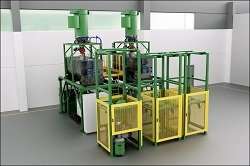Extinguisher powder reused in fertilisers and fire retardants

An EU-funded project has recycled phosphate from exhausted extinguishing powder to produce fertilisers for agriculture and flame retardants for the wood sector.
The Italian-based company ProPHOS recovered phosphate from exhausted extinguishing powder with funding from the Horizon 2020 PHOSave project by developing an environmentally friendly process for removing the silicon oil component. Monoammonium phosphate and ammonium sulphate were recovered for use in agriculture, and flame retardants for chipboard.
The recycling process involved sieving the initial waste to remove metal parts and plastic debris, then homogenisation, and washing the extracted powder and extracting the silicon oil using organic solvents. A second operation removed the residual dye and any contaminant, heavy metals etc.
Researchers studied different sorbents for use in this step, ranging from inorganic materials like clays, and zeolites to organic matter such as lignin-based materials or chitosan. ProPHOS chose agents commonly used in the food industry like brewer's yeast and yoghurt bacteria to treat the powder and actively remove the oil.
New fertilisers for improved crops
According to project coordinator and chief operating officer of ProPHOS Chemicals, Marco Michelotti, PHOSave aims to improve the sustainability of agriculture by introducing new innovative fertilisers, which meet the requirements laid down in the new EU fertiliser regulation. He says, "We developed several fertiliser formulations for various crops, adding natural bio-stimulant obtained through enzymatic hydrolysis of the organic matrix."
All these compounds can improve the nutrient use efficiency of the plant, thereby enhancing tolerance to biotic and abiotic stress and reducing fertiliser consumption. "The bio-stimulant positively affects plant physiology by acting on photosynthesis, protein synthesis and phenolic composition and it can significantly reduce water stress," Michelotti explains.
The main wood sector users are chipboard panel producers. Therefore, PHOSave has begun testing new flame-retardant formulations to achieve the highest class of resistance according to the European EN 13896 and French AFNOR NF P 92 501 standards.
Environmental and economic benefits
PHOSave provides considerable benefits to the environment. In particular, liquid and/or microgranulated fertilisers with higher surface area and higher homogeneity will be produced, significantly increasing crop productivity. "Each ton of fertiliser produced using recycled material will save around 500 kg of raw materials and prevent the emission of about 480 kg of CO2 and the use of about 430 cubic metres of water," claims Michelotti.
Furthermore, trade association official data shows that in Italy alone there are at least 10 million kilograms of exhausted extinguishing powders not properly disposed of, despite being termed a 'special waste'. This is partly due to the prohibitive cost, of which a large part is for transport. "Estimates at the EU level indicate that the annual quantity of exhausted extinguishing powders requiring treatment and disposed is 100 million kilograms," observes Michelotti. "PHOSave will help to fight illegal processes of disposal or re-use of exhausted extinguishing powder, which is currently a problem in Europe."
The project has already received several expressions of interest from relevant international organisations in the field of fertilisers, agrochemicals and flame retardants for the wood panelling sector. In addition, it will boost the competitiveness of SMEs and job growth in the market of waste management and disposal.
Provided by CORDIS



















